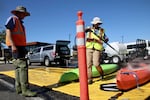
After quagga mussels were detected in the Snake River, the Idaho State Dept. of Agriculture set up boat decontamination stations in Twin Falls, as seen here in September 2023. ISDA asked everyone who had been in the water during a month-long stretch to get their boats, kayaks and fishing gear cleaned.
Rachel Cohen / Boise State Public Radio
Michael Stephenson has spent years worrying about a tiny invasive creature smaller than a fingernail. Then, last fall, they arrived. The larval form of quagga mussels and one adult were found in the Snake River near Twin Falls.
“I’m feeling very anxious about it,” said Stephenson, who works as a biologist at Idaho Power. The company operates 17 hydroelectric plants on the Snake River and its tributaries, 15 of which are downstream of where quagga mussels were detected.
Stephenson said the small bivalves are a big problem. They spread rapidly – a female can produce a million eggs each year – and they attach to pretty much any surface in the water. They can clog intakes for drinking and irrigation water systems, and hydroelectric turbines.
The Columbia River Basin is the only major river system in the country without an invasive mussel infestation. The Pacific NorthWest Economic Region estimates it would cost the Northwest $500 million a year to deal with.
Related: Oregon Fish & Wildlife expert says quagga mussels will be catastrophic for fish and water systems
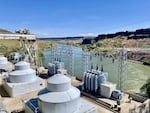
Lower Salmon Falls Dam near Hagerman, as seen in May 2024, produces enough power for about 46,000 homes. It's roughly 40 miles downstream of where quagga mussels were found near Twin Falls.
Rachel Cohen / Boise State Public Radio
On top of an Idaho Power dam near Hagerman, Stephenson points to a metal filter where water flows from the reservoir into the power house. It’s one of the initial points where quagga mussels could interfere with the system. They’d start to encrust the steel bars, Stephenson said, reducing the amount of water entering the dam.
The company currently uses a mechanical rake to keep sticks and vegetation out, but prying quagga mussels off could require scuba divers. The mussels could also target other pipes that bring in water to cool the system as the turbines are spinning; without the cold water, they could overheat.
After a visit to the southwest to see how the operators of Hoover Dam handle quagga mussels in Lake Mead, Idaho Power is considering buying special ultraviolet lights to kill baby mussels floating through its facilities.
“If we get an infestation in the Snake River, it may be the biggest problem we’ve dealt with yet, as far as infrastructural issues,” Stephenson said.
Related: Boat brought into Oregon contaminated with invasive quagga mussels, the first finding of the year
Last fall, Idaho poured a copper-based chemical into the river to try to eradicate the mussels. Similar toxins have worked to kill mussels elsewhere, but this treatment, in a major river, was unprecedented.
“That’s been weighing quite a bit on my mind,” said Nic Zurfluh, the invasive species bureau chief for the Idaho State Department of Agriculture. “Just gauging how effective the treatment was last fall.”
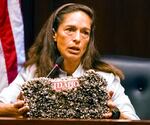
FILE - In this Jan. 6, 2017, file photo, Idaho Senate Minority Leader Michelle Stennett, D-Ketchum, shows a three month growth of invasive species the quagga mussel during the legislative preview at the State Capitol building in Boise, Idaho.
Otto Kitsinger / AP
Zurfluh said it’s been a long winter of waiting to see if the mussels are gone. They stop reproducing in colder months so they’re not easily detectable then. As the temperatures warm, Zurfluh’s team will begin collecting water samples around the state with an emphasis on the Snake River near Twin Falls, searching for signs of mussels.
Thanks to money from the legislature, those efforts will double in scale this summer. But Zurfluh cautions that answers might take time.
“Not having detections, I would take that as really great news,” he said. ”But just knowing that’s not going to tell the full picture until we go quite a little while with non-detects.”
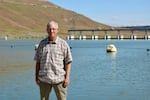
Michael Stephenson, a biologist at Idaho Power pictured in May 2024, is investigating how quagga mussels in the Snake River could affect hydropower operations and how the company can prepare.
Rachel Cohen / Boise State Public Radio
The tiny mussels are hard to find. It might take a few months, even a few years, to get an “all-clear.”
If the mussels are still around and float downstream they could pose a big threat to anadromous fish that migrate from inland spawning grounds to the ocean and bring vital nutrients back – nutrients the quagga mussels absorb. The mussels are expert filter feeders, said Anthony Capetillo, an invasive species biologist with the Nez Perce Tribe and a tribal member.
“If the quagga mussels are sucking all the oxygen and all the nutrients out of the water, then that takes away from the fish, so they’re not able to grow as they usually would,” Capetillo said.
Salmon in particular, he says, are already suffering because of dams and climate change, and quagga mussels, with their sharp shells coating fish ladders, could make their migration journeys more treacherous.
“All the money that we’ve been putting into all these projects to get these salmon and steelhead and lamprey back into these waters,” Capetilo said. “All of that could potentially be for nothing if we allow these invasives to come and take hold.”
A lot is at stake, he said, for a region that values clean water and access to the outdoors, but perhaps even more so for tribal communities.
“If we do lose parts of our identity,” he said, “lose our resources, we can’t really measure what those losses are.”
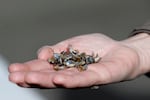
Sgt. Pam Taylor of the Washington Dept. of Fish and Wildlife displays invasive quagga mussels during a demonstration of a boat inspection for reporters, Tuesday, Feb. 25, 2020, at a boat launch in Olympia, Wash.
Ted S. Warren / AP
Even further downstream, Justin Bush, the aquatic invasive species policy coordinator for the Washington Department of Fish and Wildlife, said it could take as little as a week for floating veligers to make it from Twin Falls to that state’s borders.
“We feel like this threat is right on our doorstep,” he said. “It’s causing us to think about a new timeline, new actions, and new levels of funding that will be required in both the short and long term.”
Last fall, as soon as the mussels were detected in Idaho, Washington deployed its monitoring crews closer to the border. They didn’t turn anything up.
Now, the state will have a specific Snake River mussel monitoring team, fully-staffed boat check stations in the southeast region and a new mussel-sniffing dog.
“All eyes are on Idaho and we’re waiting for more information,” Bush said.
Idaho officials hope their eradication efforts have staved off an infestation, Zurfluh said.
At the Twin Falls waterfront, the state is requiring all boats entering and leaving the river to be washed down to contain any remaining mussels from spreading to other water bodies. Plus, prevention is still key, Zurfluh said. It would just take a single boat or kayak carrying new mussels to spark another introduction tomorrow.
Find reporter Rachel Cohen on X @racheld_cohen
Copyright 2024 Boise State Public Radio